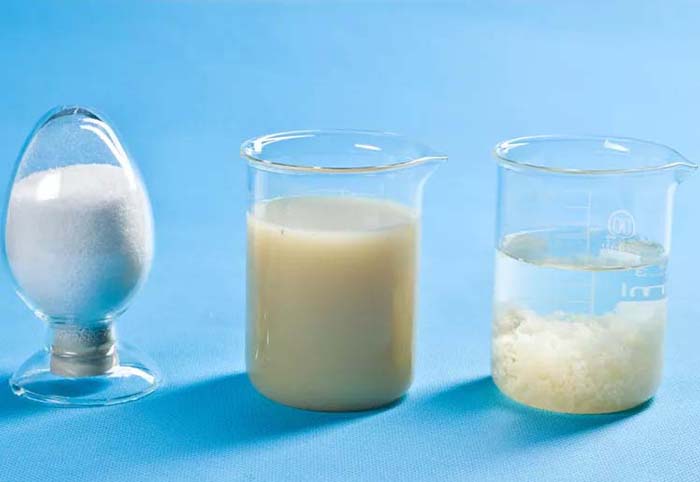What Is Polyacrylamide PAM
Polyacrylamide PAM is a water-soluble linear polymer polymerized by free radical initiation of acrylamide monomer. It is a hard glassy solid at room temperature, and has the forms of glue, latex, white powder, translucent beads and flakes. It is easily soluble in water and almost insoluble in organic solvents, but the dissolution rate is affected by factors such as molecular weight and ionicity. When dissolving PAM chemicals, it needs to be done at room temperature, and it is easy to decompose when the temperature exceeds 150°C.As one of the most widely used varieties of water-soluble polymers, it has good flocculation properties and can reduce the frictional resistance between liquids.
| Item | APAM | CPAM | NPAM |
| Solid Content ,(%) | ≥90 | ≥90 | ≥89 |
| Molecular Weight, (million) | 18~22 million | 8~12 million | 3-10 million |
| Hydrolyzing degree ,(%) | 10~30 | / | / |
| Ion degree,(%) | / | 10~60 | / |
| Ion content | / | / | ≤5 |
| Effective pH value | 7.0~14.0 | 1.0~14.0 | 1.0~8.0 |
| Dissolving time(minutes) | ≤90 | 40~60 | ≤90 |
| Packing | Net 25kg / paper bag with inner plastic bag | ||
According to ionic properties, polyacrylamide can be divided into four types: Anionic Polyacrylamide APAM, Cationic Polyacrylamide CPAM , Non-ionic polyacrylamide NPAM and amphoteric polyacrylamide.
Anionic polyacrylamide (APAM) has a negative charge on its molecular chain and is usually polymerized by acrylamide and anionic monomers. It can also be obtained by non-ionic hydrolysis. Common anionic monomers include carboxyl and sulfonic acid groups. It is anionic in acidic or neutral media, highly sensitive to salts, and has a good flocculation effect. APAM is often used for flocculation and sedimentation of various industrial wastewaters, such as steel plant wastewater, electroplating plant wastewater, metallurgical wastewater, coal washing wastewater and other sewage treatment and sludge dehydration.
Cationic polyacrylamide (CPAM) has positive charges on its molecular chain and is generally copolymerized with acrylamide and cationic monomers. CPAM has a good flocculation and precipitation effect on negatively charged suspended particles in water and is suitable for sludge dewatering, papermaking wastewater, printing and dyeing wastewater, and non-ferrous metal smelting wastewater.
Nonionic polyacrylamide (NPAM) is a linear polymer with no charge on the molecular chain. It is relatively stable under acidic or neutral conditions and has almost no electrical neutralization effect, but it can flocculate and precipitate suspended particles through the adsorption and bridging effect of long chains. NPAM is often used in industrial wastewater treatment, drinking water clarification and purification, etc. It can also be used as an auxiliary agent in the textile industry, sand control and sand fixation auxiliary agent, soil moisturizer, etc.
Zwitterionic polyacrylamide (Am-PAM) It has both positive and negative charges on its molecular chain and is obtained by copolymerization or modification of monomers containing anionic and cationic groups. It has the advantages of both anionic and cationic polyacrylamide, has strong adaptability under different water quality conditions, and has a wide treatment range. It can be used in industrial water treatment, refineries, mining and other fields.
Main Applications of Polyacrylamide PAM
(1) Sewage flocculation treatment
In sewage treatment, PAM chemical plays a key role as a flocculant. It can quickly aggregate and precipitate suspended particles in sewage, thereby effectively removing suspended matter, organic matter and some heavy metal ions.
For industrial wastewater, such as wastewater generated by papermaking, printing and dyeing, chemical industry and other industries, PAM flocculant can significantly improve the treatment effect of wastewater, reduce the chemical oxygen demand (COD) and biochemical oxygen demand (BOD) of wastewater, and make it meet the discharge standard.
In urban sewage treatment, PAM polyacrylamide helps to improve the dewatering performance of sludge, reduce the volume of sludge, and facilitate subsequent treatment and disposal.
(2) Drinking water purification
The PAM water treatment chemical can be used for the purification of drinking water, removing impurities, suspended matter and microorganisms in water through flocculation and precipitation, and improving the water quality of drinking water.
In the process of raw water pretreatment, PAM chemical can effectively remove colloidal substances and fine particles in water, providing good water quality conditions for subsequent deep treatment
Mechanism of Action in Water Treatment
Adsorb pollutants. Polyacrylamide has strong adsorption capacity. It can purify water by adsorbing pollutants on its surface. PAM can adsorb pollutants quickly and has a remarkable effect. Especially for sewage rich in heavy metals, the adsorption capacity of PAM is more obvious.
Flocculation role. Sewage contains a large amount of suspended solids and colloidal substances, which are difficult to remove through traditional physical or chemical methods. Adding PAM chemical can aggregate these suspended and colloidal substances into larger clumps, thereby facilitating subsequent solid-liquid separation. Specifically, the molecular structure of PAM contains a large number of carbonyl groups and amino groups. These functional groups can form hydrogen bonds or electrostatic forces with ions or molecules in the water, causing the fine particles and colloidal substances suspended in the water to form larger clusters, thus reduce the amount of suspended solids and turbidity in water.
Catalyze oxidation reactions. By adding PAM powder, the oxidation reaction in the water can be accelerated, thereby reducing chemical oxygen demand and biochemical oxygen demand. This helps improve water cleanliness and prevents contamination of water bodies with pollutants rich in organic waste.
Antibacterial effect. PAM chemical can also inhibit the reproduction of bacteria and viruses in water bodies. This helps prevent water bodies from being contaminated by bacteria and viruses and ensures safe water quality.

